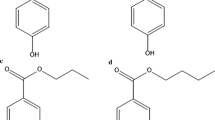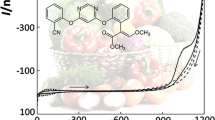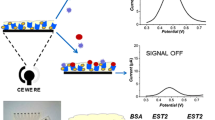Abstract
In this study, the degradation of two organophosphate pesticides, namely, propetamphos and azamethiphos, in the presence of Ag+ at different mole ratios was investigated. Moreover, the kinetic and degradation pathways of both chemicals in the range of 0–60 min were explored. Gas chromatography equipped with a thermionic specific detector was used to investigate the pesticide degradation kinetics and mechanism. The results show that the degradation rate of both pesticides follows first-order kinetic. The first-order rate constant and the half-life of reaction were in the range of 0.002–0.143 min−1, 187–2.1 min, and 0.005–0.164 min−1 and 60–1.8 min, for propetamphos and azamethiphos, respectively, at ambient temperature (25 ºC). Because group containing sulfur atom is a better leaving group than group containing nitrogen, the rate of degradation of azamethiphos is higher than propetamphos. In a higher mole ratio of Ag+ to pesticides, the degradation rate was increased, and it is possible to predict the rate of degradation of pesticides according to the chemical composition of leaving group.





Similar content being viewed by others
Data availability
The data used to support the findings of this study are available from the corresponding author upon request.
References
Abd El-Ghany, T., & Masmali, I. (2016). Fungal biodegradation of organophosphorus insecticides and their impact on soil microbial population. Plant Pathology and Microbiology, Z, 5, 1000349.
Barisic, J., Cannon, S., & Quinn, B. (2019). Cumulative impact of anti-sea lice treatment (azamethiphos) on health status of rainbow trout (Oncorhynchus mykiss, Walbaum 1792) in aquaculture. Scientific Reports, 9(1), 1–13.
Bouhala, A., Lahmar, H., Benamira, M., Moussi, A., & Trari, M. (2020). Photodegradation of organophosphorus pesticides in honey medium by solar light irradiation. Bulletin of Environmental Contamination and Toxicolog y, 104(6), 792–798.
Dehghani, M., & Fadaei, A. (2012). Potoccatalytic oxidation of organophosphorus pesticides using zinc oxide. Research Journal of Chemistry and Environment, 16(3), 104–109.
Edwards, D. R., & Brown, R. S. (2013). Development of metal-ion containing catalysts for the decomposition of phosphorothioate esters. Biochimica et Biophysica Acta (BBA)-Proteins and Proteomics, 1834(1), 433–442.
Firozjaei, S. A. A., Latifi, A. M., Khodi, S., Abolmaali, S., & Choopani, A. (2015). A review on biodegradation of toxic organophosphate compounds. Journal of Applied Biotechnology Reports, 2(2), 215–224.
Hassan, J., Kamrani, R., Tabarraei, H., Pirri, F., Nojani, M. R., & Hayes, A. W. (2021). Degradation of phosalone by silver ion catalytic hydrolysis. Toxicology Mechanisms and Methods, 31(3), 182–187. https://doi.org/10.1080/15376516.2020.1861672
Ismail, M., & Al-Taher, A. (2011). Effect of propetamphos on the male rats reproductive system. Environmental Toxicolog y and Pharmacolog y, 31(2), 333–338.
Kaushal, J., Khatri, M., & Arya, S. K. (2021). A treatise on organophosphate pesticide pollution: Current strategies and advancements in their environmental degradation and elimination. Ecotoxicology and Environmental Safety, 207, 111483.
Kuo, L. Y., Dill, K. M., Shariati, Y. A., Bright, E. K., & McCormick, T. (2017). Novel application of simple molybdates: Catalytic hydrolysis of an organophosphate neurotoxin under mild aqueous conditions. Inorganica Chimica Acta, 466, 1–7. https://doi.org/10.1016/j.ica.2017.05.007
Lartiges, S. B., & Garrigues, P. P. (1995). Degradation kinetics of organophosphorus and organonitrogen pesticides in different waters under various environmental conditions. Environmental Science & Technology, 29(3), 1246–1254.
Millàn, D., Tapia, R. A., & Pavez, P. (2019). Efficient nucleophilic degradation of an organophosphorus pesticide “diazinon” mediated by green solvents and microwave heating. Frontiers in Chemistry, 6, 669.
Pehkonen, S. O., & Zhang, Q. (2002). The degradation of organophosphorus pesticides in natural waters: A critical review. Critical Reviens in Environmental Science and Technolog y, 32(1), 17–72.
Sarkouhi, M., Shamsipur, M., & Hassan, J. (2016). Metal ion promoted degradation mechanism of chlorpyrifos and phoxim. Arabian Journal of Chemistry, 9(1), 43–47.
Sharma, A., Shukla, A., Attri, K., Kumar, M., Kumar, P., Suttee, A., Singh, G., Barnwal, R. P., & Singla, N. (2020). Global trends in pesticides: A looming threat and viable alternatives. Ecotoxicology and Environmental Safety, 201, 110812.
Sidhu, G. K., Singh, S., Kumar, V., Dhanjal, D. S., Datta, S., & Singh, J. (2019). Toxicity, monitoring and biodegradation of organophosphate pesticides: A review. Critical Reviews in Environmental Science and Technology, 49(13), 1135–1187.
Theriot, C. M., & Grunden, A. M. (2011). Hydrolysis of organophosphorus compounds by microbial enzymes. Applied Microbiology and Biotechnology, 89(1), 35–43.
Yang, X., Xu, D. C., Qiu, J. W., Zhang, H., Zhang, Y. C., Dong, A. J., Ma, Y., & Wang, J. (2009). Simultaneous determination of 118 pesticide residues in Chinese teas by gas chromatography-mass spectrometry. Chemical Papers, 63(1), 39–46. https://doi.org/10.2478/s11696-008-0090-3
Author information
Authors and Affiliations
Contributions
Data acquisition: Ali Pourshaban-Shahrestani and Gholamreza Shams; methodology: Jalal Hassan; writing—review and editing: Mohammad-Kazem Koohi; revising the text: Mohmmad Amrollahi Sharif Abad.
Corresponding author
Ethics declarations
Competing interests
The authors declare no competing interests.
Ethical approval
All authors have read, understood, and have complied and are aware that with minor exceptions, no changes can be made to authorship once the paper is submitted.
Conflict of interest
The authors declare no competing interests.
Additional information
Publisher's note
Springer Nature remains neutral with regard to jurisdictional claims in published maps and institutional affiliations.
Rights and permissions
Springer Nature or its licensor (e.g. a society or other partner) holds exclusive rights to this article under a publishing agreement with the author(s) or other rightsholder(s); author self-archiving of the accepted manuscript version of this article is solely governed by the terms of such publishing agreement and applicable law.
About this article
Cite this article
Hassan, J., Koohi, MK., Pourshaban-Shahrestani, A. et al. Catalytic degradation of propetamphos and azamethiphos using silver ion. Environ Monit Assess 195, 761 (2023). https://doi.org/10.1007/s10661-023-11356-w
Received:
Accepted:
Published:
DOI: https://doi.org/10.1007/s10661-023-11356-w




